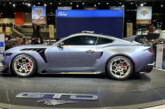Waymo is a self-driving technology company with a mission to make it safe and easy for people and things to move around. We’re determined to improve transportation for people around the world, building on self-driving technology developed over eight years in Google’s labs.
We believe self-driving technology has enormous commercial potential and will enable us to rethink some of the ten trillion miles that motor vehicles travel around the world every year. As a standalone business, our goal is to commercialize this technology and build products that can help millions of people. As Waymo, one of our next steps will be to let people use fully self-driving cars to do everyday things like run errands or commute to work. Over the long term we believe self-driving cars will be useful in ways the world has yet to imagine. Waymo will explore many different opportunities for self-driving technology.
We completed the world’s first fully self-driving trip on public roads on October 20, 2015. Our vehicle did not have a steering wheel, foot pedal or test driver on board as it drove from a doctor’s office to a park and through typical Austin neighborhoods in everyday traffic (i.e., no police escorts or closed course). While there have been many rides with self-driving cars before, including our own, this was the first time any car has completed a trip from start to finish on public roads without a test driver on board. Our software was fully responsible for all the driving. As a passenger, Steve Mahan became the first person in the world to ride in a fully self-driving car on public roads. For Steve, who is legally blind, this was the first time he was alone in a car in 12 years.
Our first priority is safety in developing self-driving technology. This ride was the culmination of six years of careful development and testing, which at the time included over a million miles of autonomous driving on public roads, three million miles a day of simulated driving, and testing our car’s performance in thousands of unique or rare scenarios on our private test track. To prepare for fully self-driving trips, we put multiple layers of safety preparations in place, including programming the vehicle to slow down and come to a safe stop in the event that it came across a situation it did not recognize.
At the most basic level, driving is about processing information around you and making decisions based on those signals. The same is true for our self-driving cars. To determine its location, our car uses a combination of detailed, 3D digital maps (including information like lane markers and traffic signals), and an array of cameras, lasers and radars that can see 360 degrees (in contrast, the human field of vision is 120 degrees), day or night.
Our self-driving software can recognize drivers, cyclists, and pedestrians and because of our millions of miles of real-world and simulated driving, our cars can anticipate how others may behave. Our cars are programmed to drive conservatively. For example, they will slow down near a construction zone, wait 1.5 seconds after a red light turns green before moving through an intersection, and nudge towards the center of the lane to give nearby cyclists extra room.
Waymo metrics to-date:
● Over 2 million miles of autonomous driving to date. Measured in time, that’s 300 years of on-the-road driving experience.
● Over 1 billion miles of simulated driving in 2016 alone
● Test driving in four cities (Mountain View, CA; Austin, TX; Phoenix, AZ; Kirkland, WA)
● Nearly 60 vehicles testing on public roads today
● Developed three generations of self-driving vehicles—including our prototype with no steering wheel or pedals—with a fourth on the way
Current state of transportation:
● Today, more than 1.25 million people die on our global roadways every year. That’s the equivalent of a 737 falling out of the sky every hour of every day. In the US — 35,000 people lost their lives in 2015 — and it’s a number that is going up.
● Meanwhile, 20 to 30 million Americans who are old enough for a license are unable to drive because of disability
● The average urban commuter in the U.S. wastes 42 hours annually stuck in traffic jams. This costs us a combined $160 billion a year in gas burned and time lost.
● And vehicles spend 94% of their time idle and parked.



